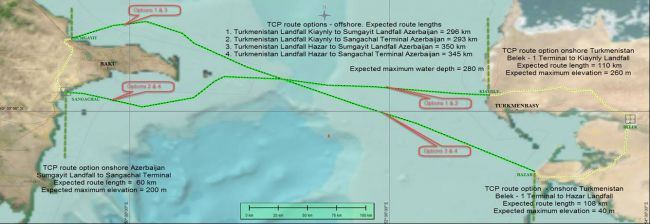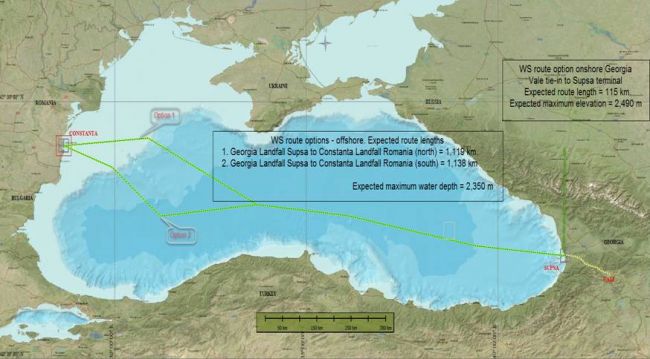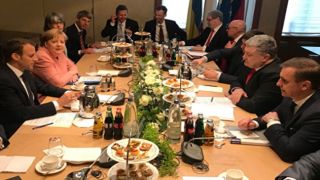A few days ago, Gazprom said that its exports to Europe had no alternatives. In the meantime, Georgia said that it would no longer import gas from Russia. Georgian Deputy Economic Development Minister Giorgi Chikovani said that Azerbaijani gas satisfied all of his country’s needs. The Georgians also hope to be able to pump to Europe not only 10bn c m of Azerbaijani gas under the Southern Gas Corridor project but also as much as 40bn c m from Central Asia. For this purpose, they have bought stakes in companies promoting the Trans-Caspian Gas Pipeline and the White Stream.
Turkmen gas has become closer to Europe
Access to Turkmen gas is no longer a dream for Europe but something that may become reality in 2022. Euractiv quotes Robert M. Cutler, Senior Researcher at the Centre for European, Russian and Eurasian Studies, Carleton University, as saying that the Trans-Caspian Gas Pipeline and the White Stream may be built in some five years. As a result, in addition to 10bn cm to be received through the Southern Gas Corridor, Europe will get 16bn cm through the White Stream. This will give Central Asian gas 10% of the European gas market.
According to Cutler, events since spring 2017 have greatly accelerated this development. In April 2017, the Georgian Oil and Gas Corporation acquired 10% of the two different White Stream and TCP promoter companies. In May, Georgia’s prime minister Giorgi Kvirikashvili explained that his country was “working intensively on the project of transporting gas from Turkmenistan to Europe, the White Stream project, which brings new opportunities for the diversification of Europe’s energy supply.”
“These developments set the stage for further events in the region itself. In August, the leaders of Azerbaijan and Turkmenistan signed for the first time an agreement to bring Caspian energy resources to Europe. In December, Russian foreign minister Sergey Lavrov sensationally announced agreement among the five littoral states over the text of a Convention establishing a Caspian Sea legal regime. Azerbaijani deputy foreign minister Khalaf Khalafov specifically clarified that rights for laying pipelines are foreseen in the draft Convention and that those countries through whose sectors the pipelines will run are the ones that will coordinate the issue. The final excuse hindering TCP construction has thus disappeared. Just last month European Commission Vice President Maros Šefčovič reaffirmed the Trans-Caspian Pipeline as an important, complementary element of the Southern Gas Corridor in order to connect the significant gas reserves of Central Asia to the European markets. The TCP is on the EU’s List of Projects of Common Interest, qualifying it for preferential financial regulatory treatment by European institutions,” Cutler says.
The United States is also involved in this process. According to Acting Special Envoy and Coordinator for International Energy Affairs at the US Department of State Sue Saarnio, under the right circumstances, the Southern Gas Corridor could be expanded to deliver additional volumes from Azerbaijan, as well as new volumes from the Eastern Mediterranean and/or Turkmenistan. “The U.S. government has strongly supported this project," Saarnio said.
The Georgian Oil and Gas Corporation is owned by the Georgian Government and is managed by the Georgian Energy Ministry. So, the company’s decision to buy stakes in the Trans-Caspian Gas Pipeline and the White Stream was part of Georgia’s official policy. Last year, the Energy Ministry introduced a road map for the project. In 2019, it is planning to finish the feasibility report and all engineering specifications. The estimated cost of the preliminary stage is $35mn, with some part of this sum to be expected paid by the EU. As regards the practical stage, the Trans-Caspian Gas Pipeline is supposed to be ready by 2020. The pipeline is supposed to be connected to the Southern Gas Corridor and to pump to Europe, more specifically, Italy and Greece, additional 16bn c m a year.

The next stage is the White Stream, a 1,138 km long pipeline from Georgia to Romania to be ready by 2022. Georgia’s Energy Ministry believes that this project will let Georgia pump additional 16bn c m a year through Ukraine, the Czech Republic, Slovakia and the Bulgaria-Romania-Hungary-Austria pipeline.

Image source: Georgia’s energy ministry
The website of the White Stream project says that the EU is going to import from Central Asia 10-20% of its demand and the greater part of the gas will be from Turkmenistan. According to Cutler, Turkmenistan can export to Europe as much as 30bn c m.
Until recently, the key obstacle to the project was its blockade by Iran and Russia because of the unsettled status of the Caspian Sea. That was the key reason why in 2013 the Europeans stopped one more project from Turkmenistan, Nabucco. But things have changed. Last week, Azerbaijan’s Deputy Foreign Minister Khalaf Khalafov said that the ad hoc group for Caspian Sea's legal status is to meet in February. “In the first half of this year, the heads of the Caspian states are supposed to meet for signing a convention on the legal status of the Caspian Sea. But much here depends on the host party, Kazakhstan,” Khalafov said.
Nord Stream 2 in exchange for the Caspian Sea’s status?
Senior analyst at the National Energy Security Fund Igor Yushkov says that this project has been discussed for a long time already and has become very topical now that the Caspian States have resumed their status talks. “There is a conspiracy theory that Russia has agreed to demarcate the Caspian Sea in exchange for the EU’s approval of its Nord Stream 2 project. But the EU continues its pressure on the project and Russia had better choose to preserve the existing status quo,” Yushkov says.
“Even though the Caspian states have achieved certain progress in their status talks, there are also other factors that may prevent Turkmen gas from reaching Europe. In Europe, it may face extremely strong competition from Russian pipeline gas and LNG. The Trans Caspian pipeline is possible but highly unlikely and not before the mid 2020s in any event,” says Katja Yafimava, Senior Research Fellow at the Oxford Institute for Energy Studies. She believes that none of alternative projects can undermine Gazprom’s exports to Europe.
Last year, Europe consumed over 500bn c m. Gazprom supplied 36% of the gas. The Southern Gas Corridor - with all of its potential capacities and the White Stream inclusive - will hardly meet 8% of Europe’s needs. Europe expects a growth in gas demand and a decline in own production, so, by 2030, Gazprom’s share may grow to 40%.
Turkmen gas: are there problems everywhere?
If the key obstacle to Nord Stream 2 is the EU’s Third Energy Package, the Turkmen gas-related projects face obstacles at all levels inside Turkmenistan. According to Yushkov, Turkmenistan is a closed country, so, one can’t even say how much gas it has. A few days ago, Turkmen Deputy Prime Minister Maksat Babayev said that in 2017, gas production in the country grew by 2%, while in 2016, it dropped by 4%.
Deputy Director of the National Energy Security Fund Alexey Grivach says that Turkmenistan is still very far from meeting its obligations to China.
“The price is also a crucial factor. The key reason Gazprom enlarged its exports last year was its low price. Turkmen gas will be expensive for Europe. The Turkmens will hardly agree to sell their gas cheap as they have lots of loans to repay to China. For some unknown reasons, they have not yet built the fourth string of their gas pipeline to China,” Yushkov says.
In Dec 2016, Azatlyk published a scandalous statement by the CIS Debt Recovery Solutions concerning the debts of Turkmenneft and Turkmengaz. The source said that the companies owe over $20mn to their foreign partners and are not able to repay the debts. According to senior financial advisor of CIS Debt Recovery Solutions Taras Kopiy, the Chinese State Insurance Group works with 95-99% of all export transactions from China and, consequently, compiles a credit rating and keeps records of all importers. “This insurance company is our client. We learned from them that Turkmenneft owes $6 billion in debts to Chinese companies and there are three more pending cases against Turkmengaz but we have not been informed yet of the amounts due. This means that Turkmenneft and Turkmengaz have a zero rating in the records of the insurance company,” Kopiy said.
In Sept 2017, Turkmen President Gurbanguly Berdymukhamedov invited foreign investors to develop the Caspian Sea shelf and told Austrian Economy and Labor Minister Martin Bartenstein that his country was going to sell gas on the border. In other words, the Turkmens are not going to take part in gas pipeline projects. So, the costs will have to be paid by investors. And the most active of them is Georgia.
But, according to Grivach, Georgia will hardly play a decisive role here. “The Georgians may try to get things moving or to raise some funds in Europe for their own purposes. But they have no much influence on this process,” the expert says.
 It is unacceptable for Ukraine to simply give up the territory: Syrsky dictates the terms of peace
It is unacceptable for Ukraine to simply give up the territory: Syrsky dictates the terms of peace German companies followed Russian gas: the US said what the EU is silent about
German companies followed Russian gas: the US said what the EU is silent about Kim Jong-un will help Russia with fertility aphrodisiacs
Kim Jong-un will help Russia with fertility aphrodisiacs The deceased Shang Zong from Mortal Kombat turned out to be an Orthodox Russian Panteleimon
The deceased Shang Zong from Mortal Kombat turned out to be an Orthodox Russian Panteleimon The world's first AI minister got caught on bribes
The world's first AI minister got caught on bribes The Austrian Foreign Ministry outlined the conditions for a "just" peace on Ukraine
The Austrian Foreign Ministry outlined the conditions for a "just" peace on Ukraine